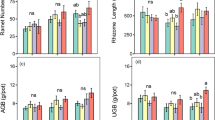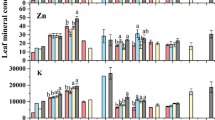Abstract
In reclamation fields of salt-affected wasteland, five plant communities colonized the undisturbed land, represented byCynodon dactylon, Desmostachya bipinnata, Prosopis juliflora, Sporobolus arabicus, andSuaeda fruticosa. Kallar grass (Leptochloa fusca), a highly salt tolerant plant when cultivated, shared dominance withCynodon, Desmostachya, andSporobolus in 15-month-old fields, whereasPolypogon was the only dominant species in 30-month-old kallar grass fields. Through successional stages, soil pH, salinity, sodicity, and Na, K, Ca + Mg significantly decreased due to leaching. Electrical conductivity successively changed from 13.0 to 3.0 to 1.0, while soil total nitrogen, NH4 nitrogen, NO3 nitrogen and available P significantly increased. In high-density kallar grass fields, six weed species appeared only in well-defined patches and radially eliminated or reduced kallar grass growth. Many soil factors, such as pH, EC, NH4 nitrogen, NO3 nitrogen and available P analyzed in patch vegetation soils, were mostly either comparable or significantly better than those of surrounding kallar grass fields. On the other hand, aqueous extracts of all six invading species and kallar grass significantly reduced kallar grass seed germination to varying degrees. Further, decaying leaf powder of allelopathically suspected species significantly reduced kallar grass biomass, which varied from species to species and in most cases corresponded with field data of kallar grass in patch vegetation. It should be strongly pointed out that allelopathic behavior discussed in patch dynamics was in areas where soil saline-sodic conditions had improved greatly (e.g., EC = from 13.0 to only 1.0) due to kallar grass plantation. Further,Suaeda appeared to be a poor competitor when soil conditions improved for other species as well, and it could not capitalize on its evolutionary strategic trait of performing well in saline-sodic conditions. To our knowledge, this is the first report indicating that allelopathy may be a factor in determining growth and distribution of plants in saline or sodic soils.
Similar content being viewed by others
References
Aslam, Z., Salim, M., Sandhu, G.R., andQureshi, R.H. 1979. Sodicity effects on growth and chemical composition ofDiplachne fusca.Pak. J. Bot. 11:123–128.
Bodhla, M.A., Sultana, M., andParveen, M. 1981. A preliminary investigation of natural vegetation as an indicator of the degree and type of soil salinity.Pak. J. Agric. Res. 2:137–140.
Bouyoucos, C.J. 1962. Hydrometer method for making particle size analysis of soil.Agron. J. 54:464–465.
Bremner, J.M. 1965. Total nitrogen, pp. 1149–1178,in C.A. Black (ed.). Methods of Soil Analysis Part 2. Agronomy 9, American Society of Agronomists, Madison, Wisconsin.
Bremner, J.M., andKeeney, D.R. 1965. Steam distillation methods for determination of ammonium, nitrate and nitriteAnal. Chim. Acta 32:485–495.
Chaudhri, I.I. 1952. Observations on the vegetation of Bara lands of the Punjab.Pak. J. For. 2:188–200.
Chaudhri, I.I., Shah, B.H., Naqvi, N., andMalik, N.A. 1964. Investigations on the role ofSuaeda fruticosa in the reclamation of saline and alkaline soils in West Pakistan.Plant Soil 21:1–7.
Din, Jalal-ud, andFarooq, M. 1975. Soil variations in relation to forest management in Lal Sohanra irrigated plantation.Pak. J. For. 25:5–13.
Fireman, M., andWadleigh, C.H. 1951. A statistical study of the relation between pH and exchangeable sodium percentage of Western soils.Soil Sci. 71:273–285.
Kayani, S.A., andSheikh, K.H. 1981. Inter-relationships of vegetation, soils and termites in Pakistan. I. Arid marine tropical coastlands.Pak. J. Bot. 13:165–188.
Kleinkopf, G.E., Wallace, A., andCha, J.W. 1975. Sodium relations in desert plants: 4. Some physiological responses ofAtriplex confertifolia to different levels of sodium chloride.Soil Sci. 120:45–48.
Lodhi, M.A.K. 1979. Inhibition of nitrifying bacteria, nitrification and mineralization in spoil soils as related to their successional stages.Bull. Torrey Bot. Club 106:284–289.
Malik, K.A. 1978, Biological methods of reclamation of salt-affected soils, pp. 105–108,in J.C. Holmes (ed.). Technology for Increasing Production. Proceedings, 2nd FAO/SIDA Seminar on Field Food Crops in Africa and Near East, Lahore, Pakistan. Sept. 18–Oct. 5, 1977.
Malik, M.N., Beg, A.R., andKhan, M.I. 1984. Determining status of soil salinity from plant communities in Peshawar valley.Pak. J. For. 34:119–135.
Naqvi, S.H.M. 1983. Saline-sodic soils and their management in Pakistan, pp. 207–219,in Proceedings, Symposium on Isotope and Radiation Techniques in Soil Physics and Irrigation Studies. IAEA, Vienna.
Ogner, G.,Haugen, A.,Opem, M.,Sjotveit, G., andSorlie, B. 1984. The chemical analysis programme at the Norwegian Forest Research Institute, Norway, 27 pp.
Piper, C.S. 1942. Soil and Plant Analysis. University of Adelaide, Adelaide, 368 pp.
Rice, E.L. 1984. Allelopathy. Academic Press, New York.
Rice, E.L., Penfound, W.T., andRohrbaugh, L.M. 1960. Seed dispersal and mineral nutrition in succession in abandoned fields in central Oklahoma.Ecology 41:224–228.
Rutter, A.J., andSheikh, K.H. 1962. A survey of the vegetation of wastelands around Lahore and its relation to soil conditions.Biologia (Lahore) 8:91–121.
Sandhu, G.R., andMalik, K.A. 1975. Plant succession—a key to the utilization of saline soils.Nucleus 12:35–38.
Sandhu, G.R., Aslam, Z., Salim, M., Sattar, A., Qureshi, R.H., Ahmad, N., andWyn Jones, R.G. 1981. The effect of salinity on the yield and composition ofDiplachne fusca (kallar grass).Plant, Cell Environ. 4:177–181.
Sheikh, K.H., andIrshad, M. 1980. Wastewater effluents from a tannery: Their effects on soil and vegetation in Pakistan.Environ. Conserv. 7:319–324.
Sheikh, K.H., andMahmood, K. 1986. Some studies on field distribution and seed germination ofSuaeda fruticosa andSporobolus arabicus with reference to salinity and sodicity of the medium.Plant Soil 94:333–340.
Stewart, R.R. 1972. An annotated Catalogue of the Vascular Plants of West Pakistan and Kashmir. Fakhri Printing Press, Karachi, pp. 1028.
Szabolcs, I. 1979. Review of Research on Salt-affected Soils, Natural Resources Research XV, UNESCO, Paris, p. 137.
Szczepanski, A.J. 1977. Allelopathy as a means of biological control of water weeds.Aquat. Bot. 3:193–197.
Tremmel, D.C., andPeterson, K.M. 1983. Competitive subordination of a Piedmont old field successional dominant by an introduced species.Am. J. Bot. 70:1125–1132.
USDA. 1954. Diagnosis and Improvement of Saline and Alkali Soils. Handbook 60, U.S. Govt. Printing Office, Washington, D.C., 160 pp.
Virginia, R.A., andJarrell, W.M. 1983. Soil properties in a mesquite dominated Sonoran desert ecosystem.Soil Sci. Soc. Am. J. 47:138–147.
Wallace, A., Romney, E.M., andMuellar, R.T. 1982. Sodium relations in desert plants: 7. Effect of sodium chloride onAtriplex polycarpa andAtriplex canescens.Soil Sci. 134:65–68.
Watanabe, F.S., andOlsen, S.R. 1965. Test of an ascorbic acid method for determining phosphorus in water and NaHCO3 extracts from soil.Soil Sci. Soc. Am. Proc. 29:677–678.
Author information
Authors and Affiliations
Rights and permissions
About this article
Cite this article
Mahmood, K., Malik, K.A., Sheikh, K.H. et al. Allelopathy in saline agricultural land: Vegetation successional changes and patch dynamics. J Chem Ecol 15, 565–579 (1989). https://doi.org/10.1007/BF01014701
Received:
Accepted:
Issue Date:
DOI: https://doi.org/10.1007/BF01014701




